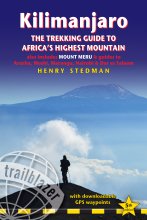'Fantastically detailed and well-presented.'
— Backpack magazine

Kilimanjaro - The trekking guide to Africa's highest mountain
Excerpt:
Minimum impact trekking
Contents List | Introduction | Planning your trip | Minimum impact trekking | Sample route: Marangu | On the Trail

‘Manya ulanyc upangenyi cha ipfuve’ – ‘Do not foul the cave where you have slept’ (A Chagga proverb that refers to the habits of the baboon who are said to ‘foul their caves’ until there comes a point where the stench compels them to find alternative accommodation.)
KINAPA (see p125) does try to keep Kilimanjaro clean. At all huts and campsites, trekking groups have their rubbish weighed by the ranger; if there’s any evidence that some rubbish has been dumped (ie if the rubbish carried weighs less at one campsite than at the previous camp) the guide could have his licence temporarily revoked and/or have to pay a heavy fine. It’s a system that would appear to have loopholes but until recently Kili was a very clean mountain, and though it can be frustrating to have to wait for your guide every morning while the rubbish is weighed, it’s a small price to pay for a pristine peak. Sadly, standards appear to have slipped recently and there is now serious concern amongst trekking agents and environmentalists about the state of some of the trails. While it’s easy to blame the authorities for the sorry state of Lemosho and other routes, trekkers are just as culpable. After all, much of it is our rubbish.
You can help Kilimanjaro become beautiful once more by following these simple rules (opposite) that apply to almost every mountain anywhere in the world.
SOME GUIDELINES FOR KEEPING THE MOUNTAIN PRISTINE
- Dispose of litter properly In theory, all you should have to do is give your litter to your crew: given the stiff punishments they receive for leaving rubbish behind (see opposite), this should ensure all waste is taken off the mountain. Unfortunately, despite all the cleaning crews and the weighing stations at each campsite, some think the litter situation is getting worse. Whatever you decide to do, don’t give used batteries to porters; keep them with you and take them back to the West where they have the facilities to dispose of them properly (the batteries that is, not the porters).
- Don’t start fires There’s absolutely no need for fires on Kilimanjaro: for cooking, your crew should use kerosene, while for heat, put another layer of clothes on or cuddle up to somebody who doesn’t mind being cuddled up to.
- Use the purpose-built latrines True, some of them could do with emptying (especially the toilet at the Barranco campsite, which is now so full that the pile of human waste is in danger of developing a snowy summit all of its own), but this is still better than having piles of poo behind all the bushes on the trail and toilet paper hanging from every bough.
- Leave the flora and fauna alone Kili is home to some beautiful flowers and fascinating wildlife but the giant groundsels rarely thrive in the soils of Europe and the wild buffalo, though they may look docile when splashing about in the streams of Kili, have an awful temper that makes them quite unsuitable as pets. It’s illegal to take flora and fauna out of the park, so leave it all alone. That way, other trekkers can enjoy them too.
- Boil, filter or purify your drinking water This will help to reduce the number of non-returnable, non-reusable, non-biodegradable and very non-environmentally friendly plastic mineral water bottles that are used on Kili.
- Stay on the main trail The continued use of shortcuts, particularly steep ones, erodes the slopes. This is particularly true on Kibo: having reached the summit, it’s very tempting on your return to slide down on the shale like a skier and you’ll see many people, especially guides, doing just that. There’s no doubt that it’s a fast, fun and furious way to get to the bottom, but with thousands of trekkers doing likewise every year, the slopes of Kibo are gradually being eroded as all the scree gets pushed further down the mountain. Laborious as it sounds, stick to the same snaking path that you used to ascend.
- Wash away from streams and rivers You wouldn’t like to bathe in somebody else’s bathwater; nor, probably, would you like to cook with it, do your laundry in it, nor indeed drink it. And neither would the villagers on Kili’s lower slopes, so don’t pollute their water by washing your hair, body or clothes in the mountain streams, no matter how romantic an idea this sounds. If your guide is halfway decent he will bring some hot water in a bowl at the end of the day’s walk with which you can wash. Dispose of it at least 20m away from any streams or rivers.
Kilimanjaro - The trekking guide to Africa's highest mountain
Excerpts:
- Contents List
- Introduction
- Planning your trip
- Minimum impact trekking
- Sample route: Marangu
- On the Trail
Price: £17.99 buy online now…
Latest tweets